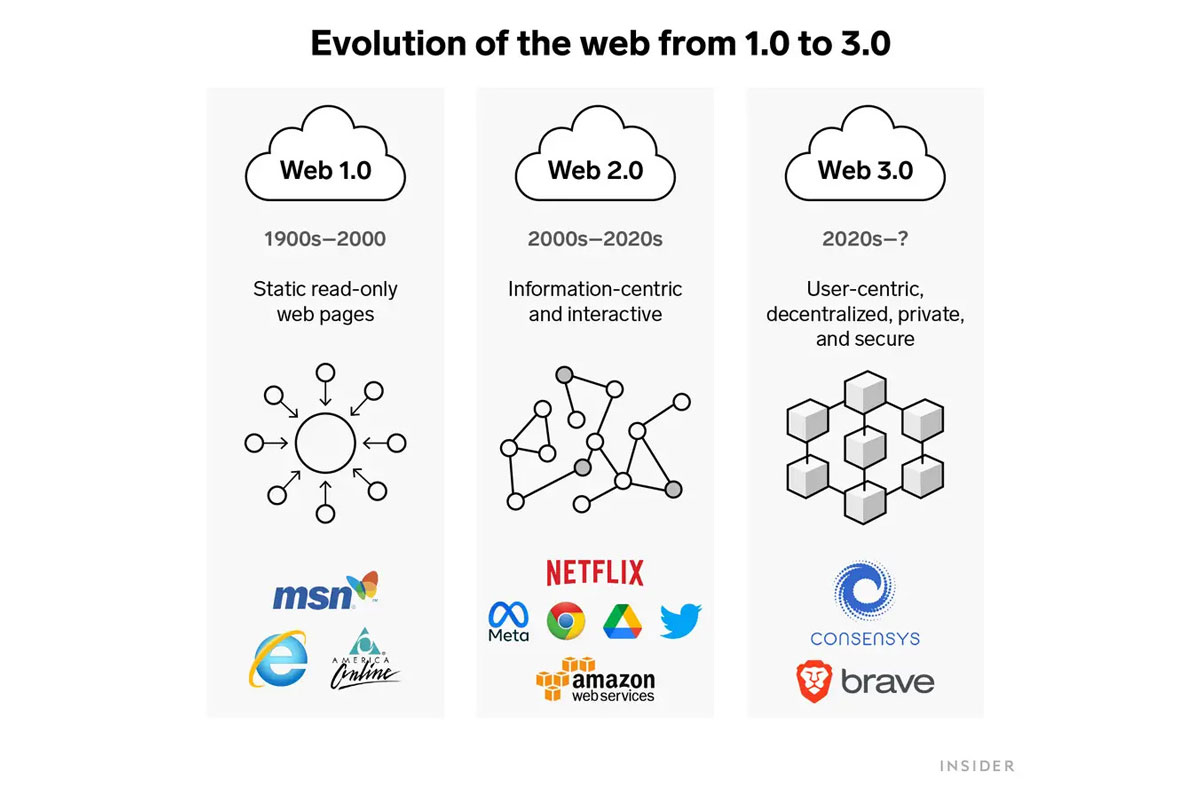Web3 has quickly become one of the most hotly debated topics on the internet, yet the term remains shrouded in a haze of techno-babble, hype and criticism. How did this relatively obscure term for a new technology become one of the most polarising talking points around?
To properly answer that question, we put together this jargon-free guide to Web3.
We’ll explain everything you need to know about “the future of the internet” in simple terms and take an unbiased look at how Web3 actually works — which will help you figure out whether Web3 is something worth investing in.
In This Web3 Guide
What is Web3?
Web3 simply refers to the next big step in the evolution of the internet. The main reason there’s so much debate and confusion around Web3 comes down to the fact that Web3 is still very much in the process of being built.
If we take major Web3 developers & advocates at their word — Web3 simply refers to the next era of the internet, which will be built on blockchain technology. An internet that runs on blockchain technology will allow everyday people greater control over their data, privacy and finances online.
Instead of massive centralized tech companies like Facebook, YouTube & Google controlling the way that you use the internet and collecting all of your data in the process, Web3 will allow you as an individual to own your very own piece of the internet.
This definition probably didn’t help all that much — so, to better understand what people mean when they say “Web3” we need to take a look at the history of the world wide web so that we can cut through the noise and figure out exactly what the “future of the internet” might actually look like.

Web1: Read Only
Web1 began in the late 1990s and came to a gracious end in 2004 as social media platforms like Facebook really kicked off. Web1 was basically just a bunch of static websites owned by companies. Websites weren’t particularly interactive.
You couldn’t do much with Web1 apart from reading things and publishing basic content for others to read. and there was very little interaction between users, with individuals rarely producing content – leading to it being known as the read-only web.
Web2: Read + Write
The Web2 era began in 2004 with the emergence of social media platforms. Instead of a read-only, the web evolved to be read-write. Instead of companies providing content to users, they also began to provide platforms to share user-generated content and engage in user-to-user interactions.
As more people came online, a handful of top companies began to control a disproportionate amount of the traffic and value generated on the web. Web 2 also birthed the advertising-driven revenue model. While users could create content, they don’t actually own it or majorly benefit from its monetization in the same way that the platforms do.
You might be thinking about how influencers/bloggers/content creators make a lot of money. This is true, but while platforms & advertisers may pay content creators for driving engagement with their products, these creators don’t actually own their space on the internet. They are still bound to top-down decisions from platforms (think YouTube, Facebook & Instagram censorship)
Web3: Read + Write + Own
The term “Web3” was actually coined all the way back in 2014 by the co-founder of Ethereum, Gavin Wood and has since become the general term for the vision of a new, better internet. At its core, Web3 uses blockchains, cryptocurrencies, and NFTs to give power back to the users in the form of ownership.
While it’s still hard to give a solid definition of what Web3 truly is, the Ethereum Organization, an industry leader of Web3 tech, outline the following principles as the most fundamental aspects of what Web3 already looks like:
- Web3 is decentralized: instead of large swathes of the internet controlled and owned by centralized entities, ownership gets distributed amongst its builders and users.
- Web3 is permissionless: everyone has equal access to participate in Web3, and no one gets excluded.
- Web3 has native payments: it uses cryptocurrency for spending and sending money online instead of relying on the outdated infrastructure of banks and payment processors.
- Web3 is trustless: it operates using incentives and economic mechanisms instead of relying on trusted third parties.
Right now Web3 is a catch-all term that includes things like The Metaverse, Decentralized Finance (DeFi), Cryptocurrencies,
Is Web3 Legit?
Because there have been a few notable, high-profile figures that have come out with Web3-critical statements, we need to go through some of these — to see if these are fatal problems or if they’re just bumps in the road.
All Hype?
Late last year, Elon Musk declared that Web3 is just a “marketing buzzword”, saying that Web3 is essentially all hype — which at the time was somewhat of a fair statement.
However, since that time, Web3 tech has grown in functionality and many projects are making enormous headway in the space while the markets (and general interest) are at an all-time low. We’ll delve into this properly just below when we discuss the best Web3 tokens that you can invest in.
Not Really Decentralized?
The other major criticism of Web3 tech is that it falls short of its ideals, particularly regarding the sacred cow of “decentralization”. Critics claim that ownership over the blockchain networks (the foundational infrastructure of Web3 infrastructure) is actually overly concentrated in the hands of early adopters and venture capitalists.
You can see how this argument unfolded in real-time on Twitter after Block Inc. CEO Jack Dorsey got into a major tiff with other tech founders and venture capitalists over Web 3.
At the heart of Dorsey’s big critique is the idea of “decentralization theatre,” where blockchain projects are decentralized in name but not in substance. Private blockchains, VC-backed investments, or decentralized finance (DeFi) protocols where just a few people hold the keys to hundreds of millions of dollars are all examples of this sort of theatre.
Seems Legit
However, if you listen closely to the words of Marc Andreessen, co-founder of venture capital firm a16z and billionaire entrepreneur who made his fortune from his early-internet company Mozaic, you’ll find that there are many solid arguments to be found for this initial centralization as it gradually becomes more decentralized over time.
Ultimately, Web3 is not without its flaws or bad actors, but the technology itself is a hotbed of potential, especially as humans migrate more of their lives online. Whether the dreams of the convicted founder are too idealistic to be put into practice will be something that everyday users will discover over the next decade as the tech grows in form and function (think Web3 versions of sites like Twitter, Instagram, Facebook, Youtube and Spotify.)
This leads us to the next step, identifying the best organizations and projects in the Web3 space and figuring out whether they’re a good investment opportunity…
Best Web3 Tokens
Because we’re still early on Web3, the tokens associated with this space will undoubtedly change in significant ways. There’ll no doubt be a new wave of cryptocurrencies and associated assets that pop up over the next few years. To kick things off — we’ll start with the token that is essential for the spread and development of Web3: Ethereum (ETH).
Ethereum (ETH)
Ethereum is a decentralized global software platform powered by blockchain technology, where developers from anywhere in the world can build new applications, programs and financial protocols.
Because Web3 will be built with blockchain tech at its core, Ethereum today is the #1 platform on where almost all of the major smart contracts, protocols and DApps (the foundational infrastructure of Web3) that exist today are built on.
Ethereum’s native token Ether (ETH) is a native currency that’s used to pay for stuff on the Ethereum blockchain, hence why ETH takes the number one spot on this list.
So, to keep it very simple: if you believe in the future of Web3 and you think that the Ethereum network has a significant role to play in establishing it, investing in ETH is a no-brainer.
Gala Games (GALA)
Gala Games is probably one of the most promising blockchain-based gaming projects in Web3 today.
While a lot of the other Web3 gaming & metaverse projects have the sort of graphics you’d expect to find in games you used to play on a friend’s computer back in 2006, Gala is doubling down on making sure players engage with great graphics and genuinely exciting gameplay.
They set themselves even further apart from the crowd by making their mission statement: “blockchain games you’ll actually want to play”.
As a platform, Gala Games offers a multitude of different games to players built on the Gala Network, which uses its native token to identify in-game assets that players own. Players can literally buy and sell different parts of the game (imagine owning your own castle or hunting lodge in Runescape) by purchasing NFTs with the GALA token.
With an exciting lineup of really cool games to come, Gala Games is definitely a project to watch…
Basic Attention Token (BAT)
The Basic Attention Token (BAT) is the native token of the Brave Browser, a privacy-oriented browser that is on a mission to protect all user data from the prying eyes and exploitative data-harvesting strategies of big tech companies such as Google, Facebook (now Meta) & Amazon.
Not only does Brave block all third-party advertising from Google — which means you can watch infinite YouTube without ads — it also pays its users (in BAT) to view ads.
At its core, BAT is a blockchain-based system that anonymously tracks time and attention on websites viewed on the Brave web browser. Built on Ethereum, the goal of BAT is to efficiently distribute advertising money between advertisers, publishers, and readers of online marketing content and ads — while protecting individual privacy.
Brave Browser is also one of the most “Web3-ready” browsers available as it comes with full wallet integration and can access a lot of blockchain-based web protocols where other browsers like Chrome & Safari cannot.
Super Quick Summary of Web3
- Web3 is the next major step in the evolution of the internet that will allow everyday people from all walks of life to express more autonomy over their financial and personal destiny online.
- The internet began with Web1 where people could only read content. It then evolved into Web2 where people could read and write content. Web3 is the future where people can read, write and own parts of the internet, instead of “renting” it from centralized companies.
- Web3 is only just getting started, and despite a wealth of criticism and market turmoil, the projects that are invested in building the infrastructure that will give rise to “the future of the internet” show no signs of slowing down.
Read Next:
